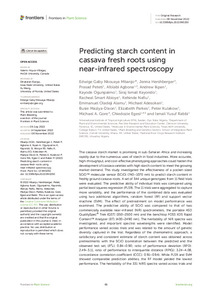| dc.contributor.author | Mbanjo, E. |
| dc.contributor.author | Hershberger, J.M. |
| dc.contributor.author | Peteti, P. |
| dc.contributor.author | Agbona, A. |
| dc.contributor.author | Ikpan, A. |
| dc.contributor.author | Ogunpaimo, K. |
| dc.contributor.author | Kayondo, S.I. |
| dc.contributor.author | Abioye, R.S. |
| dc.contributor.author | Nafiu, K. |
| dc.contributor.author | Alamu, E.O. |
| dc.contributor.author | Adesokan, M. |
| dc.contributor.author | Maziya-Dixon, B. |
| dc.contributor.author | Parkes, E. |
| dc.contributor.author | Kulakow, P. |
| dc.contributor.author | Gore, M.A. |
| dc.contributor.author | Egesi, C. |
| dc.contributor.author | Rabbi, I.Y. |
| dc.date.accessioned | 2022-12-13T15:29:18Z |
| dc.date.available | 2022-12-13T15:29:18Z |
| dc.date.issued | 2022 |
| dc.identifier.citation | Mbanjo, E., Hershberger, J.M., Peteti, P., Agbona, A., Ikpan, A., Ogunpaimo, K., ... & Rabbi, I.Y. (2022). Predicting starch content in cassava fresh roots using near-infrared spectroscopy. Frontiers in Plant Science, 1-16. |
| dc.identifier.issn | 1664-462X |
| dc.identifier.uri | https://hdl.handle.net/20.500.12478/7972 |
| dc.description.abstract | The cassava starch market is promising in sub-Saharan Africa and increasing rapidly due to the numerous uses of starch in food industries. More accurate, high-throughput, and cost-effective phenotyping approaches could hasten the development of cassava varieties with high starch content to meet the growing market demand. This study investigated the effectiveness of a pocket-sized SCiO™ molecular sensor (SCiO) (740−1070 nm) to predict starch content in freshly ground cassava roots. A set of 344 unique genotypes from 11 field trials were evaluated. The predictive ability of individual trials was compared using partial least squares regression (PLSR). The 11 trials were aggregated to capture more variability, and the performance of the combined data was evaluated using two additional algorithms, random forest (RF) and support vector machine (SVM). The effect of pretreatment on model performance was examined. The predictive ability of SCiO was compared to that of two commercially available near-infrared (NIR) spectrometers, the portable ASD QualitySpec® Trek (QST) (350−2500 nm) and the benchtop FOSS XDS Rapid Content™ Analyzer (BT) (400−2490 nm). The heritability of NIR spectra was investigated, and important spectral wavelengths were identified. Model performance varied across trials and was related to the amount of genetic diversity captured in the trial. Regardless of the chemometric approach, a satisfactory and consistent estimate of starch content was obtained across pretreatments with the SCiO (correlation between the predicted and the observed test set, (R2 P): 0.84−0.90; ratio of performance deviation (RPD): 2.49−3.11, ratio of performance to interquartile distance (RPIQ): 3.24−4.08, concordance correlation coefficient (CCC): 0.91−0.94). While PLSR and SVM showed comparable prediction abilities, the RF model yielded the lowest performance. The heritability of the 331 NIRS spectra varied across trials and spectral regions but was highest (H2 > 0.5) between 871−1070 nm in most trials. Important wavelengths corresponding to absorption bands associated with starch and water were identified from 815 to 980 nm. Despite its limited spectral range, SCiO provided satisfactory prediction, as did BT, whereas QST showed less optimal calibration models. The SCiO spectrometer may be a cost-effective solution for phenotyping the starch content of fresh roots in resource-limited cassava breeding programs. |
| dc.description.sponsorship | UKs Foreign, Commonwealth & Development Office |
| dc.description.sponsorship | Bill & Melinda Gates Foundation |
| dc.format.extent | 1-16 |
| dc.language.iso | en |
| dc.subject | Cassava |
| dc.subject | Starch |
| dc.subject | Spectrophotometers |
| dc.subject | Spectra |
| dc.subject | Heritability |
| dc.title | Predicting starch content in cassava fresh roots using near-infrared spectroscopy |
| dc.type | Journal Article |
| cg.contributor.crp | Roots, Tubers and Bananas |
| cg.contributor.affiliation | International Institute of Tropical Agriculture |
| cg.contributor.affiliation | Clemson University |
| cg.contributor.affiliation | Texas A&M University |
| cg.contributor.affiliation | Cornell University |
| cg.coverage.region | Africa |
| cg.coverage.region | West Africa |
| cg.coverage.country | Nigeria |
| cg.coverage.hub | Headquarters and Western Africa Hub |
| cg.researchtheme | Biometrics |
| cg.researchtheme | Biotech and Plant Breeding |
| cg.researchtheme | Nutrition and Human Health |
| cg.identifier.bibtexciteid | MBANJO:2022 |
| cg.isijournal | ISI Journal |
| cg.authorship.types | CGIAR and advanced research institute |
| cg.iitasubject | Agronomy |
| cg.iitasubject | Biometrics |
| cg.iitasubject | Cassava |
| cg.iitasubject | Food Security |
| cg.iitasubject | Livelihoods |
| cg.iitasubject | Plant Breeding |
| cg.iitasubject | Plant Production |
| cg.journal | Frontiers in Plant Science |
| cg.notes | Open Access Article; Published online: 08 Nov 2022 |
| cg.accessibilitystatus | Open Access |
| cg.reviewstatus | Peer Review |
| cg.usagerightslicense | Creative Commons Attribution 4.0 (CC BY 0.0) |
| cg.targetaudience | Scientists |
| cg.identifier.doi | https://dx.doi.org/10.3389/fpls.2022.990250 |
| cg.iitaauthor.identifier | Edwige Gaby Nkouaya Mbanjo: 0000-0002-9982-1137 |
| cg.iitaauthor.identifier | Prasad Peteti: 0000-0002-6013-8947 |
| cg.iitaauthor.identifier | Kayondo Siraj Ismail: 0000-0002-3212-5727 |
| cg.iitaauthor.identifier | Alamu Emmanuel Oladeji: 0000-0001-6263-1359 |
| cg.iitaauthor.identifier | Busie Maziya-Dixon: 0000-0003-2014-2201 |
| cg.iitaauthor.identifier | E J Parkes: 0000-0003-4063-1483 |
| cg.iitaauthor.identifier | Peter Kulakow: 0000-0002-7574-2645 |
| cg.iitaauthor.identifier | Chiedozie Egesi: 0000-0002-9063-2727 |
| cg.iitaauthor.identifier | Ismail Rabbi: 0000-0001-9966-2941 |
| cg.futureupdate.required | No |

